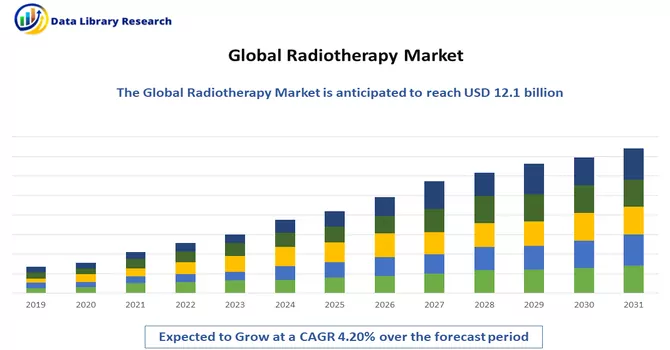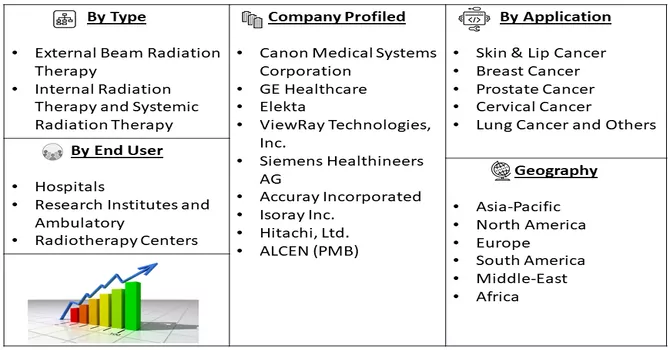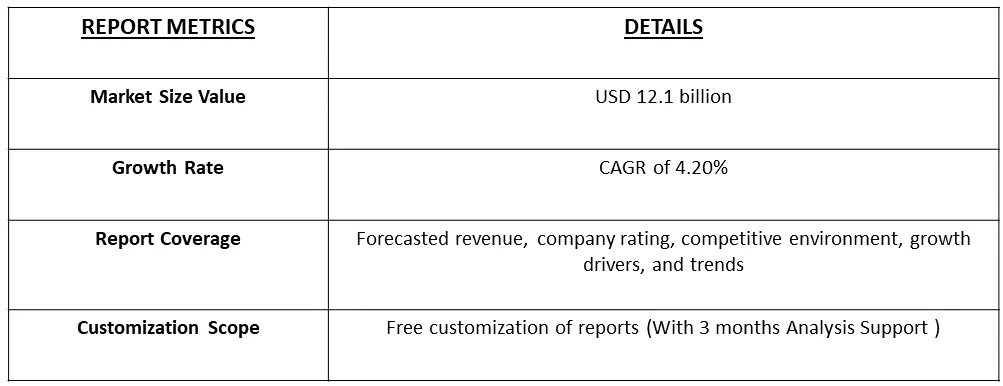The Radiotherapy Market size is estimated at USD 12.1 billion in 2023 and is expected to register a CAGR of 4.20% during the forecast period (2024-2031).

Get Complete Analysis Of The Report - Download Free Sample PDF
Radiotherapy, or radiation therapy, is a medical treatment that employs high doses of ionizing radiation to target and damage cancer cells. By disrupting the DNA within these cells, the treatment aims to inhibit their ability to divide and grow. Two main approaches are utilized: External Beam Radiotherapy (EBRT), where high-energy radiation beams are directed at the tumor from outside the body over several weeks, and Internal Radiotherapy (Brachytherapy), involving the placement of radioactive sources either inside or in close proximity to the tumor. Radiotherapy is often employed as a primary cancer treatment or in conjunction with surgery, chemotherapy, or immunotherapy. The choice depends on factors such as cancer type, stage, and location, as well as the patient's overall health, with the ultimate goal of eradicating or shrinking the tumor, relieving symptoms, and enhancing the individual's quality of life.
The radiotherapy market is propelled by several key growth-driving factors globally. Firstly, an increasing incidence of cancer cases, coupled with a growing aging population, is fueling the demand for advanced and effective cancer treatments, where radiotherapy plays a crucial role. Moreover, advancements in radiotherapy technologies, including image-guided and intensity-modulated techniques, contribute to improved treatment precision and reduced side effects, fostering market growth. The rising adoption of proton therapy, with its ability to precisely target tumors while sparing surrounding healthy tissues, is another significant factor driving market expansion. Additionally, favorable reimbursement policies and government initiatives aimed at enhancing healthcare infrastructure and accessibility to cancer treatment further stimulate the market. The trend towards personalized medicine and targeted therapies also influences the radiotherapy market, as patients increasingly seek tailored treatment options. As the industry continues to witness technological innovations, increased research and development activities, and a growing awareness of cancer prevention and early detection, these factors collectively contribute to the sustained growth of the radiotherapy market.
Market Segmentation: The Global Radiotherapy Market is Segmented by Type (External Beam Radiation Therapy, Internal Radiation Therapy and Systemic Radiation Therapy), Application (Skin & Lip Cancer, Breast Cancer, Prostate Cancer, Cervical Cancer, Lung Cancer and Others), End User (Hospitals, Research Institutes and Ambulatory and Radiotherapy Centers), and Geography (North America, Europe, Asia-Pacific, Middle East and Africa, and South America). The market size and forecasts are provided in terms of value (in USD) for the above segments.

For Detailed Market Segmentation - Download Free Sample PDF
The radiotherapy market is experiencing notable trends globally, marked by increased competitiveness and the potential for new entrants, largely fueled by robust government support, improved reimbursements, and substantial financial contributions from both public and private organizations. Advancements in technology, such as precision medicine and image-guided radiotherapy, are shaping the landscape, enhancing treatment precision and minimizing collateral damage to healthy tissues. Additionally, a growing emphasis on personalized and targeted therapies is driving innovation in radiotherapy approaches. The rise of proton therapy, with its ability to deliver focused radiation, is gaining traction. Furthermore, the integration of artificial intelligence in treatment planning and decision-making processes is becoming more prevalent, offering improved efficiency and outcomes. With a shift towards value-based healthcare, there is an increasing focus on patient-centric approaches and quality-of-life considerations, influencing the evolution of radiotherapy practices and technologies. These trends collectively reflect a dynamic and evolving market that is poised for significant developments in the foreseeable future.
Market Drivers:
Increasing Number of Cancer Patients
The increasing number of cancer patients globally has become a significant health concern, driving substantial changes in the healthcare landscape. Factors contributing to this rise include an aging population, lifestyle changes, environmental factors, and increased cancer screening and detection efforts. As populations grow older, the incidence of cancer tends to rise, given that age is a significant risk factor for many types of cancer. Changes in lifestyle, such as tobacco use, unhealthy diets, and sedentary behavior, also contribute to the escalation of cancer cases. Environmental factors, including exposure to carcinogens and pollution, further compound the risk. Moreover, enhanced screening and diagnostic capabilities lead to the identification of cancer cases at earlier stages, potentially contributing to the overall increase in reported cases. The surge in cancer prevalence places a considerable burden on healthcare systems, emphasizing the importance of proactive measures such as public health campaigns, lifestyle interventions, and ongoing advancements in cancer treatment modalities to address and manage the growing number of cancer patients effectively.
Huge Government and Non-Government Investments in R&D of Cancer Treatment
Huge government and non-government investments in the research and development (R&D) of cancer treatment have become pivotal in advancing the fight against this complex and widespread disease. Governments worldwide, recognizing the immense socio-economic impact of cancer, have increasingly allocated substantial funds to support R&D initiatives aimed at discovering innovative therapies, improving diagnostic tools, and enhancing overall cancer care. These investments are instrumental in fostering collaboration between academic institutions, research centers, and pharmaceutical companies to accelerate the development of novel cancer treatments. Simultaneously, non-governmental organizations, private foundations, and philanthropic entities contribute significantly to the R&D landscape, often focusing on specific cancer types or emerging technologies. The collaborative efforts between public and private sectors in cancer R&D have led to breakthroughs in immunotherapy, targeted therapies, and precision medicine, transforming the treatment landscape and improving patient outcomes. The considerable investments underscore the global commitment to advancing cancer research, with the ultimate goal of developing more effective and personalized treatment options, early detection methods, and supportive care measures for individuals affected by cancer.
Market Restraints:
Lack of Skilled Personnel to Perform Radiotherapy
The lack of skilled personnel to perform radiotherapy has emerged as a critical challenge within the healthcare sector. Radiotherapy, a crucial component in cancer treatment, requires specialized knowledge and expertise to ensure its safe and effective administration. The demand for skilled radiotherapy professionals, including radiation therapists, medical physicists, and radiation oncologists, has escalated due to the increasing prevalence of cancer cases globally. However, the limited availability of trained personnel poses a significant barrier to meeting this demand. Factors contributing to the shortage include the intricate nature of radiotherapy techniques, the need for continuous technological updates, and the complexity of treatment planning and delivery. Additionally, the high cost and duration of specialized training programs may deter individuals from pursuing careers in radiotherapy. The shortage of skilled personnel not only affects the timely and efficient delivery of radiotherapy services but also compromises the quality of patient care. Addressing this issue necessitates concerted efforts from educational institutions, healthcare organizations, and policymakers to invest in training programs, offer incentives for professionals in the field, and create a supportive environment that encourages the growth of skilled personnel in radiotherapy.
In the initial phases of the COVID-19 pandemic, the radiotherapy market experienced substantial disruptions attributable to the breakdown of the supply chain for radiotherapy devices and consumables, resulting in shortages and delayed deliveries. Notably, COVID-19 restrictions imposed on hospitals significantly impacted oncologic care, including radiation therapy, as healthcare facilities directed resources towards the treatment of COVID-19 patients. This redirection led to a notable reduction in the capacity for providing radiotherapy services in many hospitals and clinics, as reported in an article published by the NCBI in February 2022. However, as the healthcare industry adapted to the challenges posed by the pandemic, the widespread adoption of telemedicine and a surge in research studies have played pivotal roles in revitalizing the radiotherapy market. This resurgence is expected to persist and follow an upward trajectory throughout the forecast period, reflecting the resilience and adaptability of the radiotherapy sector in the face of unprecedented global challenges.
Segmental Analysis:
Intensity-Modulated Radiation Therapy (IMRT) Segment is Expected to Witness Significant Growth Over the Forecast Period
Intensity-Modulated Radiation Therapy (IMRT) represents a sophisticated and advanced technique in the field of radiation oncology, designed to enhance the precision and effectiveness of cancer treatment. Unlike conventional radiation therapy, IMRT allows for the precise modulation of the intensity of the radiation beams directed at the tumor. This is achieved through the use of computer-controlled linear accelerators that can adjust the intensity of each radiation beam, delivering varying doses to different parts of the tumor. The primary advantage of IMRT lies in its ability to conform the radiation dose to the specific shape and size of the tumor while minimizing exposure to surrounding healthy tissues and organs. This precision is particularly valuable in treating tumors located near critical structures or in cases where sparing adjacent normal tissues is essential. IMRT is utilized for various cancer types, including prostate, head and neck, brain, and breast cancers. Its effectiveness in optimizing treatment outcomes, reducing side effects, and enhancing the quality of life for cancer patients has established IMRT as a significant advancement in radiation therapy, contributing to the continual evolution of cancer treatment modalities.
Breast Cancer Segment is Expected to Witness Significant Growth Over the Forecast Period
Radiotherapy plays a crucial role in the comprehensive treatment of breast cancer, which is the most common cancer among women globally. Following surgical interventions like lumpectomy or mastectomy, radiotherapy is often employed to target residual cancer cells, reducing the risk of recurrence. External beam radiotherapy, including techniques like Intensity-Modulated Radiation Therapy (IMRT), is commonly utilized to precisely deliver radiation to the affected breast or chest wall. Additionally, accelerated partial breast irradiation (APBI) and brachytherapy may be considered in specific cases. The goal of radiotherapy in breast cancer is to destroy or damage cancer cells while minimizing exposure to surrounding healthy tissues. This adjuvant treatment not only contributes to improving local control but also enhances overall survival rates. The decision to incorporate radiotherapy is based on factors such as tumor characteristics, stage, and surgical outcomes. Ongoing research and technological advancements continue to refine radiotherapy approaches, emphasizing the importance of personalized and effective treatment strategies for breast cancer patients.
Hospitals Segment is Expected to Witness Significant Growth Over the Forecast Period
Hospitals serve as pivotal hubs in the delivery of radiotherapy, housing specialized departments with advanced equipment such as linear accelerators and brachytherapy devices essential for precise cancer treatment. In a multidisciplinary setting, radiation oncologists, medical physicists, and radiation therapists collaborate within hospitals to tailor comprehensive treatment plans for individual patients, offering psychological support and follow-up care. The hospital environment facilitates research and innovation, driving advancements in radiotherapy techniques, and serves as a training ground for healthcare professionals specializing in this field. Efficient resource management, collaboration with external entities, and a commitment to education contribute to hospitals playing a central role in ensuring the accessibility, quality, and continuous improvement of radiotherapy services for cancer patients.
North America Region is Expected to Witness Significant Growth Over the Forecast Period
North America is poised to exhibit substantial growth in the radiation therapy market throughout the forecast period, driven by various factors such as the escalating prevalence and incidence of cancers, the presence of key industry players in the region, and the introduction of new products. Recent data from the American Cancer Society, updated in January 2023, underscores breast cancer as the most common cancer in women in the United States, accounting for 30% of all new female cancer cases annually. The projected 297,790 new cases of invasive breast cancer and 55,720 cases of ductal carcinoma in situ (DCIS) by the end of 2023 highlight the urgent need for advanced radiotherapy treatments. The burden of cancer is expected to propel the demand for radiotherapy in the country, necessitating the development of advanced treatments and contributing to overall market growth. Additionally, prominent industry players in the region are actively engaged in radiotherapy-related advancements, further fueling market growth. Recent positive results from a clinical trial by SkinCure Oncology for Image-Guided Superficial Radiotherapy (IGSRT) and innovative solutions showcased by GE Healthcare at the American Society for Radiation Oncology (ASTRO)-2021 event are indicative of the region's commitment to driving advancements in radiotherapy. With these factors in mind, North America is positioned to offer significant opportunities for the radiation therapy market, fostering overall growth during the analysis period.

Get Complete Analysis Of The Report - Download Free Sample PDF
The global and regional radiotherapy market is characterized by intense competition, driven by factors such as government support, augmented reimbursements, and financial contributions from both private and public organizations. This environment heightens the potential for new entrants in the studied market. Despite being dominated by a select few major players, the market dynamics indicate a significant level of attractiveness for new competitors. This attractiveness is attributed to the favorable conditions created by governmental backing, increased financial support, and improved reimbursement mechanisms. The combination of these factors not only fosters a competitive landscape but also encourages the entry of new entities into the radiotherapy market, contributing to its dynamic and evolving nature. Some of the key market players working in this segment are:
Recent Development:
1) In May 2023, GE Healthcare introduced a trio of advanced radiotherapy instruments, comprising intelligent radiation therapy (IRT), auto-segmentation, and an enhanced Magnetic Resonance (MR) radiation therapy suite named AIR Open Coil Suite. These innovations mark a significant stride in the field of radiotherapy, offering sophisticated tools to enhance treatment precision and efficiency.
2) In February 2023, RefleXion Medical achieved a milestone with the approval of SCINTIX biology-guided radiotherapy by the United States Food and Drug Administration (FDA). This cutting-edge treatment is designed to address both early and late-stage cancers, showcasing a breakthrough in cancer therapy. These advancements underscore the ongoing efforts in the medical field to introduce state-of-the-art technologies that have the potential to revolutionize cancer treatment methodologies and improve outcomes for patients.
Q1. What was the Radiotherapy Market size in 2023?
As per Data Library Research the Radiotherapy Market size is estimated at USD 12.1 billion in 2023.
Q2. At what CAGR is the Radiotherapy market projected to grow within the forecast period?
Radiotherapy market is expected to register a CAGR of 4.20% during the forecast period.
Q3. What are the Growth Drivers of the Radiotherapy Market?
Increasing Number of Cancer Patients and Huge Government and Non-Government Investments in R&D of Cancer Treatment are the Growth Drivers of the Radiotherapy Market.
Q4. What segments are covered in the Radiotherapy Market Report?
By Type, By Application, End-User and Geography these segments are covered in the Radiotherapy Market Report.
Data Library Research are conducted by industry experts who offer insight on industry structure, market segmentations technology assessment and competitive landscape (CL), and penetration, as well as on emerging trends. Their analysis is based on primary interviews (~ 80%) and secondary research (~ 20%) as well as years of professional expertise in their respective industries. Adding to this, by analysing historical trends and current market positions, our analysts predict where the market will be headed for the next five years. Furthermore, the varying trends of segment & categories geographically presented are also studied and the estimated based on the primary & secondary research.
In this particular report from the supply side Data Library Research has conducted primary surveys (interviews) with the key level executives (VP, CEO’s, Marketing Director, Business Development Manager and SOFT) of the companies that active & prominent as well as the midsized organization
FIGURE 1: DLR RESEARH PROCESS

Extensive primary research was conducted to gain a deeper insight of the market and industry performance. The analysis is based on both primary and secondary research as well as years of professional expertise in the respective industries.
In addition to analysing current and historical trends, our analysts predict where the market is headed over the next five years.
It varies by segment for these categories geographically presented in the list of market tables. Speaking about this particular report we have conducted primary surveys (interviews) with the key level executives (VP, CEO’s, Marketing Director, Business Development Manager and many more) of the major players active in the market.
Secondary ResearchSecondary research was mainly used to collect and identify information useful for the extensive, technical, market-oriented, and Friend’s study of the Global Extra Neutral Alcohol. It was also used to obtain key information about major players, market classification and segmentation according to the industry trends, geographical markets, and developments related to the market and technology perspectives. For this study, analysts have gathered information from various credible sources, such as annual reports, sec filings, journals, white papers, SOFT presentations, and company web sites.
Market Size EstimationBoth, top-down and bottom-up approaches were used to estimate and validate the size of the Global market and to estimate the size of various other dependent submarkets in the overall Extra Neutral Alcohol. The key players in the market were identified through secondary research and their market contributions in the respective geographies were determined through primary and secondary research.
Forecast Model
